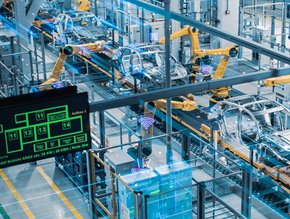Aspen Technology explores pharma’s manufacturing future

The pandemic may have fast-tracked digitalisation in the pharmaceutical industry by more than five years, but much remains for companies to accomplish.
Some 44% of 400 pharma industry professionals in Europe and the U.S. participating in the latest research by AspenTech and FT Longitude pointed, for example, to increased agility and operational efficiency as their foremost digital transformation goals. Yet many barriers to progress still persist, with cultural immaturity one of the most prominent. Nearly one-in-four (23%) pharma companies agreed C-suite changeovers complicate their organisation’s digital transformation. In addition, more than one-in-three pharma businesses (35%) experience an element of risk aversion when it comes to digital transformation.
The all-to-familiar problem of siloed data directly impedes cross-functional collaboration for 48% of respondents, with this being more pronounced for the largest pharma businesses surveyed (US$1bn+). More than half (53%) of that group claim data silos negatively impact internal collaboration. Regulation and its complexity is widely seen as another major challenge. In line with this, a third of the survey sample recognised ‘improving regulatory compliance’ as the third most important goal for digital transformation.

Kelly Doering, Senior Director, Aspen Technology
Navigating forward in pharma manufacturing
Given the above challenges, it is clear that pharmaceutical manufacturers need to find a way forward that enables them to become more agile and digitally mature so they make better use of data. They must build the capabilities to ensure regulatory compliance. Within manufacturing and its broader supply chain, they must drive operational efficiencies end-to-end.
The first step towards achieving these aims should include an assessment of the organisation’s digital maturity with emphasis on the most significant opportunities for improvement. It is key here to gain a holistic view of all the data generated inside and outside the plant associated with manufacturing and delivery. An overarching digital reference architecture will unify and integrate data from existing systems to give operations complete transparency. Connecting suppliers is a critical part of the process with data governance, access and security protocols in place.
The second action needed is to transform paper processes to aggregate data for a complete view while eliminating costly manual involvement. Advanced software applications for planning, scheduling and batch records can help fill gaps in valuable data that can be collected, analysed and used to improve outcomes.
Step three is to determine cloud strategies early on. Moving to the cloud can be accomplished in stages. Cloud solutions can augment validated on-premises solutions, and organisations can extract data to feed machine learning. They also help with implementation of advanced digital solutions in remote locations lacking adequate IT support.
Finally, businesses should look to leverage industrial AI capabilities to empower industrial systems to operate semi-autonomously to improve patient care and increase profitability.
These steps will unlock the full potential of Industrial AI to drive greater efficiency, resilience, quality and performance. At the operational level, workers are supported with knowledge, insights and recommendations to guide their workflow and drive excellence. Complete automation of processes can occur when closed-loop systems are implemented.
Maximising financial impact
Businesses following the approaches outlined above will harvest many benefits including the ability to achieve faster time to market. Companies will profit from a more efficient production cycle that ensures quality, automates time-consuming processes, reduces risks, removes unplanned downtime and prevents bottlenecks. They can manage processes and complexities effectively with a digital workflow powered by Industrial AI across planning, scheduling, production and asset management functions.
The ability to achieve security of supply and smart-sourcing agility is another key benefit that pharmaceutical companies can achieve from digitalisation. Manufacturers gain a view of their entire network, including where the supply sits, which supplier has the capacity and which supplier will deliver with the highest quality.
This level of visibility allows workers to be incredibly agile. They can proactively spot potential supply problems, make any needed adjustments and ensure high-quality products are released on time while meeting regulatory requirements.
Pharma companies can also achieve higher levels of quality assurance and compliance confidence. Using Quality by Design (QbD) principles and process analytics, manufacturers can monitor critical quality and performance attributes to ensure final product quality within a compliant environment.
Beyond this, manufacturers can model outcomes against different scenarios that encompass asset-utilisation, changing supply and demand, product line pricing and other factors affecting quality, profitability, delivery and performance. With such outcomes-based decision-making, they can be confident that they are selecting the right options.
Having the agility to adjust operations based on outcomes gives pharma manufacturers the ability to make the best use of their facilities every day while maximising their financial impact.
Faster responses, higher quality and greater returns
While pharma’s digital transformation has been slower than other process industries, the pandemic highlighted that digitalisation will be critical to future operations. Adopting the approach outlined here is how pharmaceutical companies will put themselves in a highly advantageous position.
Irrespective of an organisation’s digital maturity, progress is more attainable through technologies (and strategic partners) that minimise unplanned downtime in manufacturing, enable faster time to market and increase security of supply.
Companies will react faster to market volatility, achieving greater returns with advanced digitalisation of their own value chain network.






